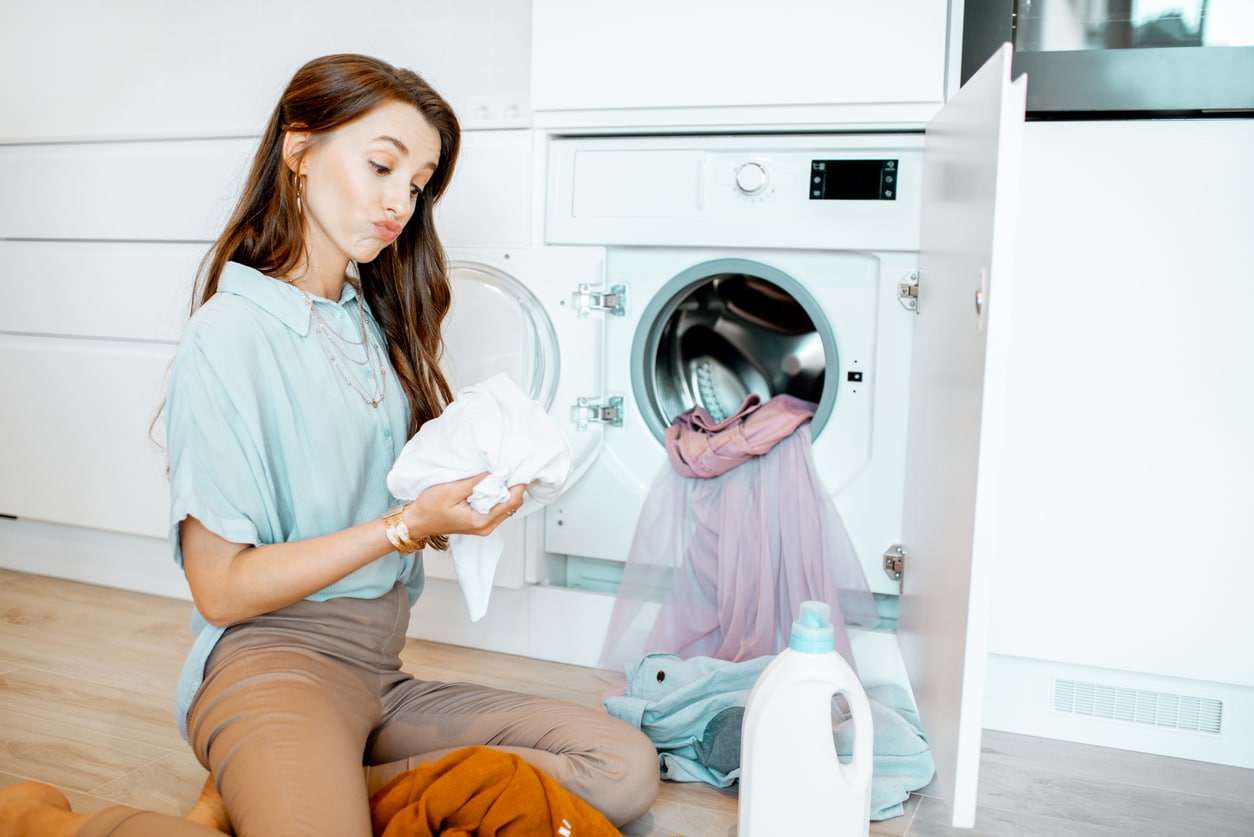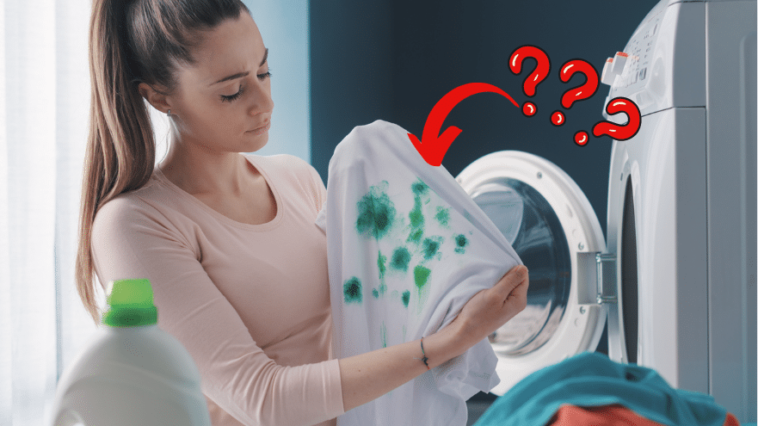Maintaining laundry is no easy feat, but this task becomes even less so when you have to deal with disappointments after going through the washing machine. Indeed, it can happen that bad odors appear after washing, but also stains that were not there before. We are then far from the promises of clean and fresh laundry expected from the washing machine. And often, you will find that changing the detergent or cleaning and disinfecting the appliance is not always enough. So, what to do? When traces appear after each wash, quickly identifying the cause of this inconvenience fortunately allows you to overcome them. Find out why laundry comes out of the washing machine stained and how to avoid it.
With our explanations and advice, you will never again see black, brown or whitish marks on your textiles. Your clothes will be clean and spotless!
How to explain stained laundry after machine washing?
Explanation 1: there are too many laundry in the machine
When there is too much laundry in the machine, white spots and white streaks may be observed. This means that the laundry was not able to mix well in the drum and the detergent was not able to dissolve well. This is often seen with washing powder. A good clue to take into account is that if the stain foams when you rub itthis means that it is indeed a laundry stain.
In this case, you will need to ensure that you comply with the weight standards for your household appliance and that you can pass your hand between the pile of laundry and the top of the drum. This will allow the water to circulate optimally.. A longer rinsing program may also reduce the risk of streaking. Finally, make sure to don’t overdose on your laundry liquid or powder so as not to clog the machine and the laundry. Current formulas are powerful enough to work without overusing them.
Good to know: if the white marks do not foam, this may mean that they are linked to limescale in the water. In this case, wash the laundry at a lower washing temperature to limit the accumulation of scale in the fibers.

Explanation 2: waste water returns to the machine
During draining, backflow of wash water (or autosiphonage) may occur. This can then leave rust stains or black or brown stains on clothing. Sometimes, you can also see laundry stains in this case. This problem is explained by a plug at the drain siphon. As used water can no longer circulate, it goes back in the opposite direction and ends up in the washing machine. You will have understood: it is not very good for laundry which finds itself mixed in dirty water. To avoid this, make sure that the drain tube is more than 65 cm from the ground. It must also sink a maximum of 10 cm inside the pipe. Also check that the drain filter is not clogged.
Explanation 3: You are using too much fabric softener
In the event of an overdose or delayed start of the machine, it is not uncommon for the softener to enter in direct contact with laundry, which may leave stains on clothes. Ideally, replace it with white vinegar which is a very good economical and ecological softener. Otherwise, be sure to use a 2 in 1 detergent (which is detergent and softener) and respect the prescribed doses by the detergent manufacturer as well as the maximum amount estimated by the washing machine compartment. Furthermore, never pour the fabric softener directly onto the laundry and avoid using it pure (always dilute it carefully in the washing bath before putting the laundry on).

Explanation 4: The resistance of the machine is clogged
The resistance is the part that heats the water. If it becomes dirty over time, deposits begin to form. And when these residues come off, they leave grayish marks on the laundry. Against these gray spots, the best thing is to carry out regular cleaning and descaling of the washing machine with white vinegar on a very hot wash cycle (90°C). This will allow the drum to be cleaned and the tank and the resistance to be descaled. If this is not enough, it may be necessary to dismantle the resistance to clean it or replace it.
Explanation 5: there is mold on the joint
If you notice gray stains on the laundry, remember to check the condition of the window. Indeed, the presence of mold on the joint can cause the appearance of traces that are difficult to remove on the linen. After washing, remember to always wipe the seal well and leave the door open to prevent moisture from soaking and mold from forming. If prevention is not enough or the stains are already there, it is possible to clean the dirty joint by following a few tips to carry out in addition to cleaning the washing machine.

Explanation 6: a metal object was in the tank
A nail, a paper clip or a key forgotten in a pocket unfortunately quickly arrives. However, in addition to risk damaging the washing machinethey can also leave rust stains on laundry after contact with water. In the event of a blockage in a hole in the drum, you can be sure that you will find these stains on many clothes before you realize it. So remember to empty each pocket before starting a wash cycle and carefully check the drum to make sure there is nothing. Furthermore, if a garment has metal parts, you can put it in a laundry net to protect other clothes. Tips for removing rust stains can be found here. If this has nothing to do with metal objects in the drum, reread explanation 2, 7 or 8.
Explanation 7: There are defective parts in the machine
Sometimes, stains can be explained by wear and tear issues within your household appliance. For example, if the belt breaks or disengages from its location, this can cause detergents to fall onto the laundry without rotating, causing stains. If the drum no longer turns or turns poorly, try replacing the belt or replacing it if it seems too worn. You can usually easily check its condition by removing the back panel of the washing machine.
It can also happen that the bearings or bearings suffer the ravages of time. You can then hear a metallic friction noise when spinning. Furthermore, you may also notice rust-colored stains as well as brown or black greasy residue on the laundry. A simple visual inspection will reveal traces of rust or oxidation.

Explanation 8: The problem is with the plumbing
Plumbing installation can sometimes explain laundry washing problems. In particular, you can find stained laundry after being put in the machine. when the piping is obsolete or if interior or exterior work has been carried out on a pipe. In this case, the water may take on a reddish tint and stain the laundry. If the problem persists after the work is completed, call a professional plumber.
How to remove a laundry stain from machine stained laundry?
If the stains concern a large part of the laundry, you can definitely consider a second machine rinse. However, this technique is time consuming and wastes a lot of water. Also, if only a few items of clothing seem affected, prefer to detach them individually.
To carry out this stain removal, use white vinegar. It is indeed an excellent natural and eco-friendly stain remover. Dilute it in water, moisten the stain with this mixture, then dab the stained area before rinsing. Another technique is to fill a basin with vinegar water (a glass of vinegar per liter of water). Immerse stained laundry well after washing in this liquid and leave to act for 15 minutes before rubbing and rinsing. Repeat if necessary.

How to remove a fabric softener stain from machine stained laundry?
If you notice a fabric softener stain on the laundry, be careful not to iron it ! Indeed, the iron risks strongly fixing the stain. Prefer to carry out careful stain removal using a few grandmother’s tips. For example, it is possible to moisten Marseille soap, rub the stain to form a crust to scrub, then rinse. Alternatively, you can form a paste of water and baking soda to rub on the stain. After a quarter of an hour of application, proceed to rinsing.
How to remove a mold stain left by the machine on laundry?
When the stain comes neither from detergent, fabric softener, nor rust, we don’t always know which solution to apply. Fortunately, for most machine stains, especially mold stains, there are effective solutions. One of them includes removing a black or gray spot of mold by letting the garment soak overnight in milk before putting the garment in the machine.
It is also possible to use ammonia against stubborn mold stains, taking care to carry out the stain removal in a well-ventilated room and using protective accessories. Just dab the area with a clean cloth soaked in ammonia. After a few minutes, all you have to do is rinse.


